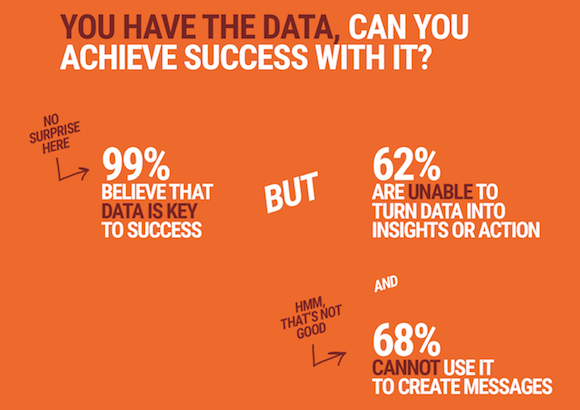The term "artificial intelligence" (AI) buzzes through all media and is a popular topic in many companies. But marketers still find it difficult to make AI tangible for their brand. This article is intended to provide more information and show marketing decision-makers how to use AI in practice.
No desire to read? Listen to our blogcast instead:
What started as a trend is now considered the future of online marketing – Artificial Intelligence (AI). This is increasingly finding its way into marketing.
AI is already helping advertisers today, especially in the automation of routine workflows and in personalized customer communication. Consumers also get a first taste of what it means to interact with AI (although they are often not even aware that there is a machine behind it). Siri, Alexa, and Chatbots are just three examples of the many modern developments.
The experts and specialists also agree. Of 208 marketing managers, 80% believe in the relevance of AI in online marketing.
It’s surprising that their words do not follow actions because only 26.5% use.
The awareness about the importance of AI is very widespread. As far as implementation is concerned, the new technology is still in its infancy. Marketers are just beginning to really understand AI.
This article should help you to better understand the topic of AI in order to be able to identify suitable locations for AI in your own company.
To do this, let’s start with the basics. Then, we will show you in which league the professionals play so that you get a better overview of the market. When it comes to AI, there are no limits to creative solutions. Curious? Then let’s begin!
What is Artificial Intelligence?
A Short Definition
We humans do things because our brain sends us signals. AI basically acts exactly the same as a data host, but with the difference that this is a machine or a program that does something.
AI as software can create things by programming them. AI can also be trained. That is, it learns from its own past behavior and optimizes it for future situations. This type of learning behavior is called "Machine Learning.”
However, in order to ensure the training and the learning process of the software, customer data must be made accessible. Only under these conditions can machines act intelligently.
For a deeper understanding: Hubspot explains AI in 6 minutes.
Advantages of AI for the User.
Marketing experts believe that AI can handle everyday tasks because it works faster, more effectively and more efficiently. These to-do's include:
- analyzing the social media data of users,
- structuring of the internally collected CRM data,
- measuring the marketing measures carried out,
- learning from customer feedback, and
- re-defining strategies based on the analysis results (e.g. choosing the right advertising message and sharing it on suitable platforms).
On the other hand, AI is very rarely (or, sometimes, not at all) used in marketing strategy and planning. The same applies to creative work because the interpretation performance of the data is still the responsibility of the people. Based on the preliminary work done by the AI (namely the automated data analysis) specialists can, however, recognize and develop sales potentials.
But this task presents companies with new challenges.
Challenges in Marketing.
In recent years, companies have invested a great deal of money in setting up so-called “internal data management systems.” These are only there to collect data and prepare it in a structured way.
There is definitely no shortage of data for companies. Some are even up to their necks in huge mountains of data. The problem is that more data is hoarded than a human can process. It lacks:
- Speed – people don't have the capacity and endurance to work uninterruptedly for long periods of time.
- Understanding – the human brain reaches its limits. It is almost impossible to keep track of these enormous amounts of data to analyze and interpret the data sets in a meaningful way.
A study by the agency Wunderman confirms this. 62% of marketers admit that they are not able to gain knowledge from the existing data to derive concrete measures. However, 99% of the respondents agree that data will determine the success or failure of marketing strategies.

Results of the study "Future Ready" by the digital agency Wunderman from 2017.
Data alone is not enough! However, people are no longer in a position to control this mass of data. In addition, it is not important to have as much data as possible, but rather to filter out the right data, recognize patterns, and use them profitably in marketing. This is where AI and machine learning come into play.
This also results in a new job profile. In the future, more Data Scientists will be hired to be the contact person for AI applications, so there is no harm in looking for suitable candidates now or training them internally.
Using the following four examples, we would like to illustrate the interaction between data and AI once again, but now with the reference to practice. Let yourself be inspired by concrete case studies for your own implementation in order to secure a decisive competitive advantage and continue to grow.
4 Examples of AI in Practice.
The following areas already benefit from AI today, especially in the interaction with (potential) customers, where fast reaction times and natural conversation are important. The first AI applications still have great potential to evolve, offering opportunities for optimization.
#1 Customer Experience.
Pattern recognition in data sets can be used to determine important customer insights for the target group. These provide insight into recurring behaviors that can be used to improve products and services.
Let's look at the example of the British hotel chain Jurys Inn. The company collected various data of online media behavior of converting customers. This gave them important demographic data and information about customers' interests. While evaluating these, they discovered a correlation between bookings and sports topics. They took a closer look and realized that website visitors were looking for hotel rooms near sports events. They then designed an extra sports page with information about various sports events and the ability to book hotel rooms near stadiums and sports venues.
By sharing valuable content with users and simplifying the booking process with the direct booking option, they were able to significantly increase their conversion rate.
User Experience Design (UX Design) in web design is the next step. The initially data-driven idea must be visualized attractively so that the user's satisfaction with the use of the product (the website) increases.

Jurys Inn Sports Hub.
#2 Advertising.
Content Targeting lautet eine Methode, mit der digitale Werbung noch effektiver ausgestrahlt werden kann, nämlich nicht neben unseriösen und unpassenden Themen. Denn KI kann lernen, auf bestimmten Websites keine Werbung zu schalten. Das schwächt die Gefahr zum Beispiel vor verheerenden Imageschäden.
Content targeting is a method by which digital advertising can be broadcast even more effectively, not alongside dubious and inappropriate topics. AI can learn not to advertise on certain websites, weakening the danger of damage to the image.
To begin, provide information and data on websites that are not suitable for your type of advertising. The AI then analyses the advertising environment of various websites. Based on the data provided, it decides whether a platform is qualified or not and, if necessary, stops the delivery of advertising on this platform. The decision of the AI is based on the website content (semantic context analysis).
Let us assume that a car sharing service does not want to place advertising in the form of display ads or commercials in environments in which failed car sharing offers are involved. Based on this data, the AI now knows that it should avoid advertising on specific websites. Furthermore, it temporarily withholds content in certain media (e.g. news sites) that have just published a news bulletin that a car sharing provider has been hacked.
In addition, AI consumers can send individual offers. Timing is crucial. This can be determined by the following factors: demographic information, the history of consumer behavior, and knowledge of the context (e.g. place, time) in which a purchase was made.
#3 Content.
Latest developments allow Natural Language Generation to automate content repeatable tasks and routine work. In the future, e-mails and chat processes will increasingly be controlled by intelligent speech systems.
Other AI programs already record changes in customer behavior in the form of numbers, as well as continuous text. This means that they independently evaluate which tone of voice and which wording works best for a specific target group. They then create their own texts.
Adobe Sensei & Adobe Experience Manager: How to make AI Content Creators more productive.
In the case of Adobe, AI can be used to create, manage, deliver, analyze, and customize content. AI doesn't have to separate data, creativity, and technology.
#4 Social Media.
I'm sure you've been on a Facebook Business Page before where a chat window suddenly pops up and greets you. That's a chatbot. In social media, they are called social bots. Nowadays, these are often used to support customers.
Social bots can clarify customer questions or problems and serve as a shopping assistant. They are able to serve several customers at the same time, 24 hours a day, 7 days a week.
They also have the ability to remember the preferences and order requests of existing customers and predict the consumer behavior of potential new customers using look-alike models (predictive analytics). These have behavior patterns similar to those of the core target group. If you help the prospective customer find the appropriate information during the initial contact (calling up a website), you can most likely convert this information as a customer.
Conversational chatbots learn with each customer contact and can individually respond to each customer. Ideally, users have the feeling that they are communicating with a real person. When it comes to winning new customers, chatbots are highly efficient, although some programming still leaves something to be desired.
GCFLearnFree.org explains the two types of chatbots.
Make room for AI in Your Business!
Considering all the points from above, AI definitely has the potential to make the daily work of marketers more productive. So let's recall the benefits of AI:
- Automate tedious routine tasks so there’s more time for strategic and creative tasks.
- Innovative approaches for personalized campaigns based on accumulated knowledge.
- Evaluate the success course of marketing measures more quickly and, if necessary, be able to give in at an early stage with the help of forecasts.
- Develop new target groups through look-alike analyses.
Of course, all these activities have one goal in mind: to increase ROI. With AI, you have the chance!
Important note: Working with data is a game with fire. Consumers are required to act responsibly because AI is fed with customer data. For this reason, we recommend that you create transparency and introduce ethical guidelines for digital behavior and data management.
We hope you enjoy discovering and trying out your possibilities!
If you need help creating effective videos, we are the right partner for you. Please feel free to contact us for a free consultation without obligation »




